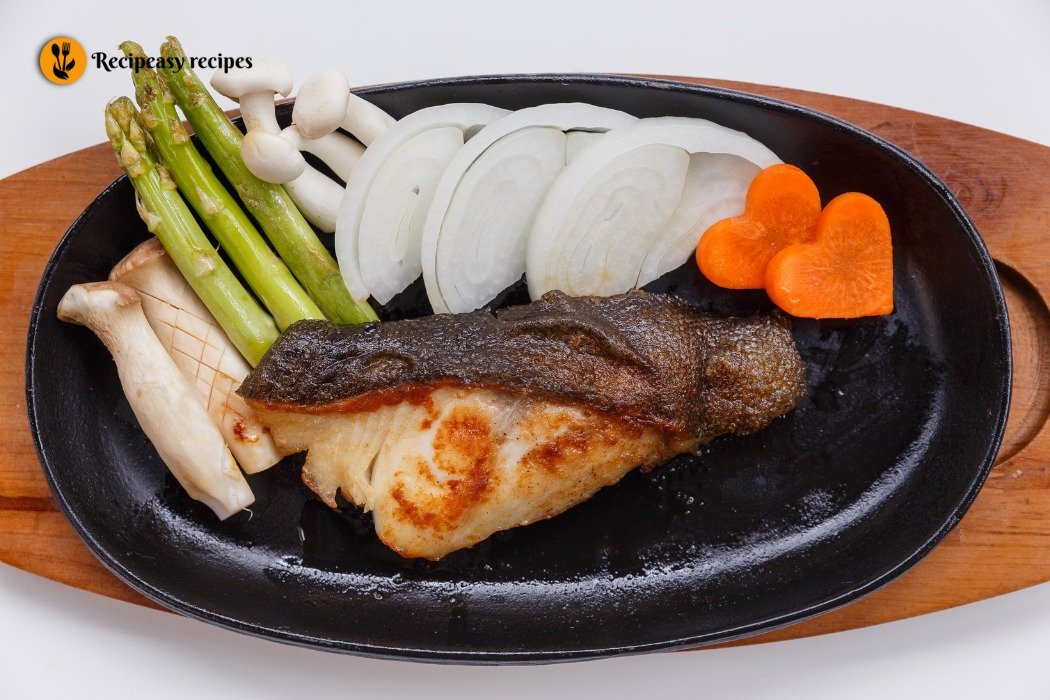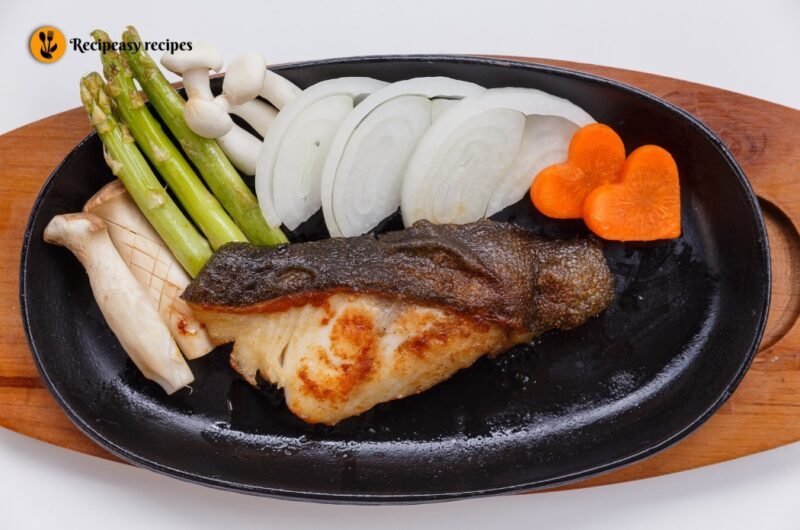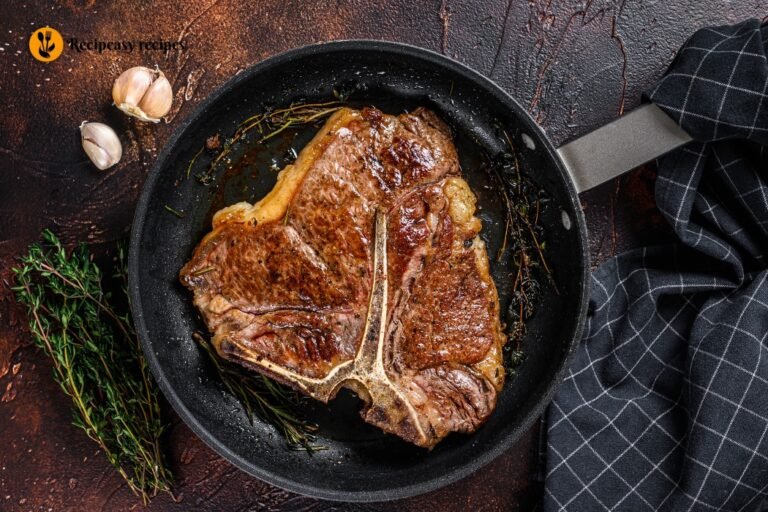Buttery Baked Sablefish Easy & Delicious Recipe
I once gave this baked sablefish recipe a try on a quiet weekend, not expecting much but it completely surprised me. The fish turned out incredibly soft, rich, and buttery, just like something you’d expect at a fancy coastal restaurant. What truly impressed me was how effortlessly this dish came together using only a few simple ingredients. The flavors were deep, smooth, and comforting. Since then, it has become one of my favorite go-to recipes for a warm and satisfying dinner.
What makes this dish special is its natural richness and smooth texture. You don’t need fancy spices just the right balance of butter, soy sauce, and lemon does the magic. It’s a perfect choice for anyone who wants a healthy yet satisfying dinner. Whether you’re cooking for family or guests, it always gets compliments. In this article, I’ll show you exactly how to make this dish step by step. Plus, I’ll share tips, serving ideas, and answer the most common questions so you can cook it with confidence.
History of Baked Sablefish Recipe
Sablefish, also called black cod, comes from the cold Pacific waters near Alaska and Canada. Known as “gindara” in Japan, it’s often marinated in miso before grilling. Its rich flavor, silky texture, and high omega-3 content make it popular worldwide. Now, it’s enjoyed in both home kitchens and high-end restaurants.
What Is Baked Sablefish Recipe?
Baked sablefish is a beautifully simple dish where tender sablefish fillets are gently seasoned and baked in the oven to bring out their naturally buttery flavor. This approach ensures the fish stays moist and flaky, while highlighting its luxurious taste and silky texture, making it a perfect blend of comfort and elegance on any plate.
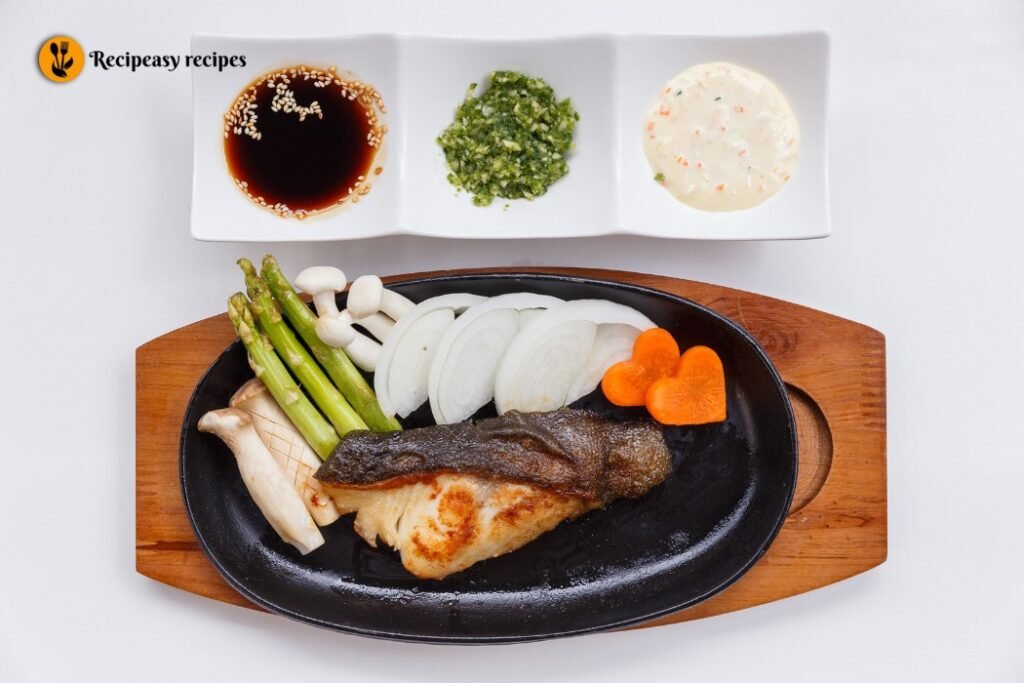
This method keeps the fish incredibly moist and allows its naturally buttery texture to shine. The flavor is rich but not overwhelming, which makes it a favorite even for people who don’t usually enjoy seafood. Baked sablefish is often paired with sauces like soy glaze, miso, or lemon butter to bring out its delicate, melt-in-your-mouth quality. It’s a great choice for both weeknight meals and special dinners.
Why You Will Love Baked Sablefish Recipe
- Rich, buttery flavor The fish turns out incredibly tender with a smooth, melt-in-your-mouth texture.
- Healthy and satisfying Packed with omega-3 fats and protein, it’s both nutritious and filling.
- Quick and easy to prepare No complicated steps or ingredients; perfect for busy days.
- Versatile for any occasion Works great for casual dinners or impressing guests on special nights.
Equipment
You’ll need just a few simple kitchen tools:
- Oven for baking the fish evenly
- Baking tray line with parchment paper for easy cleanup
- Mixing bowl to mix your marinade
- Whisk or spoon for mixing
- Pastry brush to apply marinade
- Measuring spoons to keep flavors balanced
- Tongs or spatula to lift the fillets carefully
Ingredients
Here’s what you’ll need:
- 4 sablefish fillets (about 6 oz each)
- 3 tablespoons soy sauce
- 2 tablespoons melted butter (or olive oil)
- 1 tablespoon lemon juice
- 1 teaspoon garlic (chopped or minced)
- 1 teaspoon honey or brown sugar (optional for sweetness)
- Salt and black pepper (as needed)
- Chopped parsley or chives (for garnish)
Step-by-Step Instructions of Baked Sablefish Recipe
- Preheat the oven to 400°F (200°C)
Make sure your oven is fully preheated before adding the fish. A hot oven ensures even cooking and helps lock in moisture while giving the fish a gentle, golden top layer. - Make the marinade
In a bowl, combine soy sauce, melted butter (or olive oil), lemon juice, minced garlic, honey or brown sugar (if using), salt, and black pepper. Mix it well until smooth. This creates a balanced glaze that’s savory, slightly sweet, and aromatic. - Marinate the fish (15–20 minutes)
Gently lay the sablefish fillets into the marinade, skin-side down, ensuring each piece is coated well. Let them soak for 15–20 minutes at room temperature so the flavors can deeply absorb into the tender flesh. Let them soak at room temperature so the flavors gently absorb into the flesh. Don’t skip this step it makes the final taste much richer and deeper.
- Prepare the baking tray
Line your baking sheet with parchment paper or foil for easy cleanup. Lightly brush it with oil to prevent sticking and keep the underside of the fish tender and juicy. - Place the fillets on the tray
Position the fillets on the tray, leaving a bit of space between them. Make sure the skin is facing down and the flesh side is facing up to soak in flavor while baking. - Brush with extra marinade
Use a pastry brush to coat the top of the fillets with remaining marinade. This helps caramelize the top slightly and adds moisture during baking.
- Bake for 12–15 minutes
Slide the tray into the oven and bake until the fish turns slightly golden and flakes easily when tested with a fork. Keep in mind, thicker fillets may need a little more oven time, while thinner ones will be ready sooner. Always use a fork to gently test if the fish flakes easily, it’s perfectly done. - Optional broil for 1–2 minutes
For an extra touch, switch the oven to broil mode for 1–2 minutes at the end. This gives a slight crisp to the top and deepens the color and flavor. - Let it rest and garnish
Once baked, let the fish rest for 2–3 minutes outside the oven. This allows the juices to settle, keeping the fish moist. Finish by sprinkling fresh parsley or chives before serving for a beautiful presentation and added freshness.
Nutrition Info (Per Fillet)
- Calories: 280
- Protein: 22g
- Fat: 18g (healthy fats)
- Carbs: 3–5g
- Omega-3s: High (great for heart health)
How to Serve This Dish
This dish is best served hot. Pair it with:
- Steamed veggies (like broccoli or asparagus)
- Mashed or baby potatoes
- A fresh green salad
- Rice or quinoa
Add a lemon wedge on the side and even a glass of white wine for special occasions.
Avoid Common Mistakes
- Overbaking the fish Sablefish is naturally tender and rich in oils, so it cooks fast. If you leave it in the oven too long, even sablefish’s natural moisture can disappear resulting in a dry, less flavorful texture.
- Skipping the marinade A quick 15–20 minute marinade adds flavor and moisture. Don’t skip this crucial step.
- Using too high heat Stick to the recommended 400°F. Anything higher can burn the glaze or dry out the fish.
- Not patting fish dry If you’re using thawed frozen fillets, dry them with paper towels before marinating. Excess water can affect flavor and texture.
- Crowding the pan Leave space between fillets so they cook evenly and the edges crisp slightly.
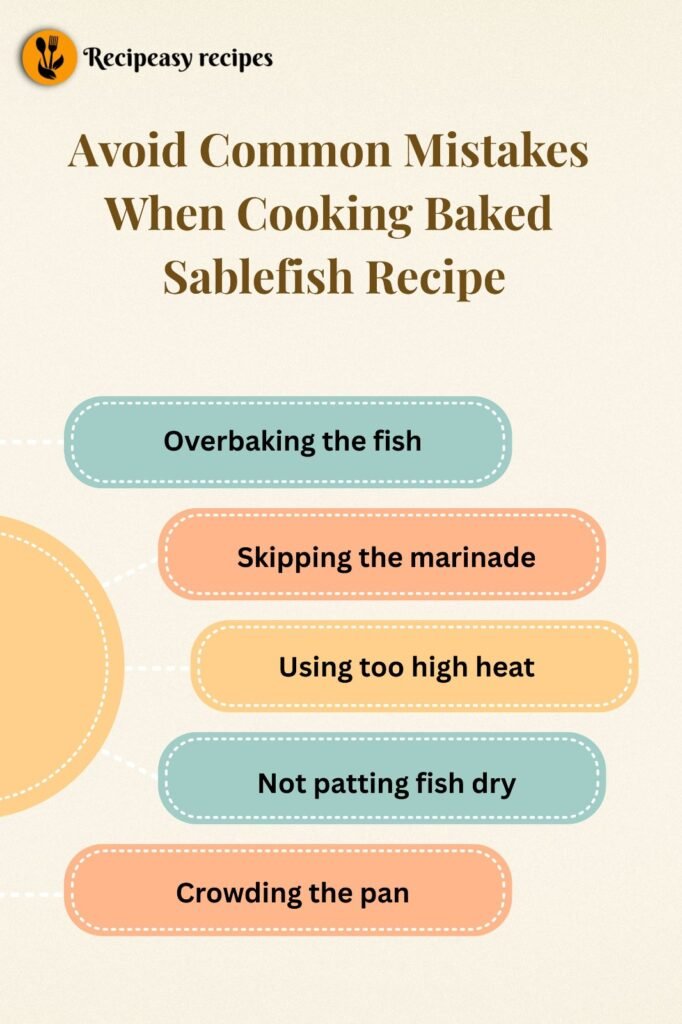
Benefits of This Recipe
- Great source of protein and omega-3 fats
- Simple and quick to cook
- Gluten-free (if you use gluten-free soy sauce)
- Makes a fancy meal with very little effort
- Low-carb and fits many healthy diets
FAQs
1. Why is sablefish so expensive?
Sablefish from Alaska’s Pacific waters is prized for its quality, sustainability, and rich omega-3s.
2. Can I use frozen sablefish?
Yes, just thaw it overnight in the fridge and pat it dry before marinating.
3. Is there a sablefish recipe with soy sauce?
Yes! This recipe includes soy sauce as a key ingredient in the marinade.
4. What does sablefish taste like?
Its rich, buttery flavor and soft, flaky texture make it a favorite, often compared to Chilean sea bass.
5. Can I prepare this in advance?
Marinate in advance, refrigerate, and bake fresh when ready; best served hot.
Final Thoughts
Baked sablefish recipe isn’t just another seafood dish it’s a comforting, flavorful experience that feels both simple and special. Whether you’re preparing a quick weeknight dinner or hosting guests, this recipe delivers a soft, buttery texture and a rich, savory flavor that leaves a lasting impression. It’s one of those meals that feels elegant without requiring hours in the kitchen. The balance of taste, health, and ease makes it stand out among fish recipes.
This isn’t just a recipe it’s a reminder that great food can come from simple steps and fresh ingredients, without being fussy or time-consuming. With a few basic ingredients and simple techniques, you can create something truly satisfying. If you’re someone who usually avoids cooking fish at home, this dish might just change your mind. Try it once, and you’ll see why it has earned a permanent place in many home kitchens including mine.
Buttery Baked Sablefish Easy & Delicious Recipe
Course: Dinner, SeafoodCuisine: JapaneseDifficulty: Easy4
servings20
minutes12
minutes280
kcalRich, buttery sablefish baked to perfection with soy sauce, butter, and lemon. Quick, healthy, and restaurant-quality dinner at home.
Ingredients
4 sablefish fillets (about 6 oz each)
3 tbsp soy sauce
2 tbsp melted butter (or olive oil)
1 tbsp lemon juice
1 tsp garlic (chopped/minced)
1 tsp honey or brown sugar (optional)
Salt & black pepper (to taste)
Fresh parsley or chives (for garnish)
Step-by-Step Instructions of Baked Sablefish Recipe
- Preheat the oven to 400°F (200°C)
Make sure your oven is fully preheated before adding the fish. A hot oven ensures even cooking and helps lock in moisture while giving the fish a gentle, golden top layer. - Make the marinade
In a bowl, combine soy sauce, melted butter (or olive oil), lemon juice, minced garlic, honey or brown sugar (if using), salt, and black pepper. Mix it well until smooth. This creates a balanced glaze that’s savory, slightly sweet, and aromatic. - Marinate the fish (15–20 minutes)
Gently lay the sablefish fillets into the marinade, skin-side down, ensuring each piece is coated well. Let them soak for 15–20 minutes at room temperature so the flavors can deeply absorb into the tender flesh. Let them soak at room temperature so the flavors gently absorb into the flesh. Don’t skip this step it makes the final taste much richer and deeper. - Prepare the baking tray
Line your baking sheet with parchment paper or foil for easy cleanup. Lightly brush it with oil to prevent sticking and keep the underside of the fish tender and juicy. - Place the fillets on the tray
Position the fillets on the tray, leaving a bit of space between them. Make sure the skin is facing down and the flesh side is facing up to soak in flavor while baking. - Brush with extra marinade
Use a pastry brush to coat the top of the fillets with remaining marinade. This helps caramelize the top slightly and adds moisture during baking. - Bake for 12–15 minutes
Slide the tray into the oven and bake until the fish turns slightly golden and flakes easily when tested with a fork. Keep in mind, thicker fillets may need a little more oven time, while thinner ones will be ready sooner. Always use a fork to gently test if the fish flakes easily, it’s perfectly done. - Optional broil for 1–2 minutes
For an extra touch, switch the oven to broil mode for 1–2 minutes at the end. This gives a slight crisp to the top and deepens the color and flavor. - Let it rest and garnish
Once baked, let the fish rest for 2–3 minutes outside the oven. This allows the juices to settle, keeping the fish moist. Finish by sprinkling fresh parsley or chives before serving for a beautiful presentation and added freshness.
Notes
- Use fresh sablefish for best flavor; thawed frozen works too (pat dry first).
- Don’t overbake fish should flake easily with a fork.
- Marinade is key: even 15 mins makes flavor much deeper.
- Broiling at the end gives a restaurant-style finish.
- Serve with rice, potatoes, or steamed veggies.
